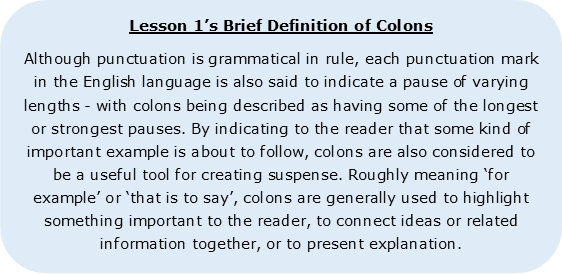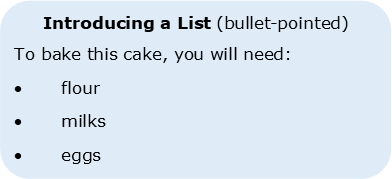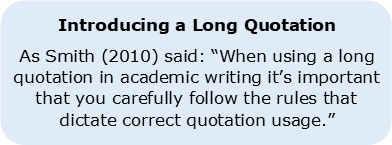What are the rules for colons in academic writing?

This is the second of three chapters about Colons and Semicolons. To complete this reader, read each chapter carefully and then unlock and complete our materials to check your understanding.
– Focus specifically on using colons in English
– Explore the ten functions of colons as a punctuation mark
– Discuss any related rules and common errors when using colons
Before you begin reading...
-
video and audio texts
-
knowledge checks and quizzes
-
skills practices, tasks and assignments
Chapter 2
In Chapter 1 of this short reader on colons and semicolons, we introduced basic definitions for these punctuation marks and outlined their fifteen most useful functions. This second chapter on the topic now focuses specifically on colons, identifying the many rules that must be followed by a writer if accuracy is important. After exploring the relevant rules for each of the ten functions of colons, a brief discussion about the most common mistakes when using this symbol is provided:


Function 1: Connecting Two Independent Clauses
While both colons and semicolons may be used to join two independent clauses instead of a comma and conjunction (such as ‘and’), a colon should only be used if the second clause amplifies, explains, paraphrases or summarises the first:


As can be seen in the first example, these two clauses are both independent in nature because they can stand alone as complete sentences. By using a colon in the second example, however, the writer is able to create a closer connection between the rigorous IELTS exam and what makes that exam so difficult. It’s important to remember that when using colons in this way, the first rule is to not use this punctuation mark to combine more than two clauses. Secondly, a writer should make sure that the two clauses they’ve joined are both closely related, with the second clause explaining, paraphrasing or summarising the first.
Function 2: Expressing Time
When writing the time, particularly in the format of a 24-hour clock, it’s possible to use a colon to separate the hours from the minutes, as is shown below:


The only rule to remember here is consistency. Clearly there is some variation in how American and British people write the time, with Americans preferring the colon and British people preferring the full stop. Whichever you choose as a writer, remember to stay consistent with that choice.
Function 3: Highlighting a Single Word
Colons may also be occasionally used when the writer wishes to point the reader toward a single cause, effect, concept or idea – as in the following:

The only rule to remember here is to make sure that the preceding expression makes it clear to the reader that you’re about to focus on only one thing.
Function 4: Introducing a Definition
Sometimes a writer may wish to produce a concise definition of an important term or a subject-specific item of vocabulary. While there are many ways of doing this successfully, one method is to precede that definition with a colon:

When introducing a definition in this way, a writer should always remember to place the colon directly between the word being defined (‘morphology’) and its associated definition (‘the study of word forms’).
Function 5: Introducing a Dialogue
Likely only useful if you’re a scriptwriter or are studying drama or media (although everyone will no doubt see colons being used in this way at some point) is that colons may be used to introduce dialogue, separating one character from another:

When a character’s name and speech are separated by a colon, it then becomes unnecessary to use speech marks (“) to indicate dialogue, as is the norm.
Function 6: Introducing a List
One of the most important functions of a colon is to introduce a list of items, whether following an independent clause or as bullet-pointed or numbered list:


Whether you capitalise or punctuate the items in a bullet-pointed or numbered list is up to you so long as you’re consistent. However, for listed elements within a sentence that do not form an independent clause, such as ‘a pen, a dictionary and identification’, the rule here is to never capitalise the first letter following the colon.
Function 7: Introducing a Long Quotation
One way in which colons are particularly useful for academic writing is that they’re able to introduce long quotations, such as the following:

There are many rules to including quotations, however, with some arguing that the quoted material should be on a new line, separately indented and without quotation marks (“) – unlike the example we’ve provided (see our short reader on quoting for more information). Whichever format you follow, be consistent, and remember that when using a colon to introduce a longer quotation, a short piece of text such as ‘as Smith (2010) said:’ should also be included.
Function 8: Providing Emphasis:
The eighth function of colons is useful for providing emphasis or an emphatic assertion about something, as in the following:

Much like when connecting two independent clauses with a colon, when adding emphasis in this way remember that the two propositions must be strongly connected together, with the second providing the main emphasis.
Function 9: Separating the Title from the Subtitle
Colons are also particularly useful when correctly formatting a reference list as they may be used to separate the title from the subtitle of a piece of work, such as a book or journal article:

In a full reference, you may in fact see the colon being used more than once, with common practice being to also separate the place of publication from the publisher:

Function 10: Using an Appositive
Finally, colons may also be used to introduce an appositive, which is when two terms that mean the same thing (but are expressed in different words) are placed next to each other. In the example below, the expression ‘the second biggest commodity’ indicates the same item as the word ‘coffee’, which follows the colon:

Of course, appositives such as this are not common in academic writing. As with the many other uses of colons, try to include expressions such as this sparingly and thoughtfully in your own work.
What are some common colon mistakes?
In addition to the rules provided for the above ten functions, we’ve also highlighted three common mistakes that students should avoid when using colons:
a) Using a colon after listing phrases
Try to avoid using a colon after phrases like ‘such as’, ‘especially’ or ‘including’ that precede lists. Remember that colons generally join two independent clauses, which is not the case when using these listing phrases. Instead, use a comma.
b) Using a colon between a verb and its object/complement
Again, if you use a colon in-between a verb and its object or complement (as in the example below) then you’re not joining two independent clauses together. The following example would therefore be considered ungrammatical:

c) Using a colon between a preposition and its object
Likewise, a colon should never be used to separate a preposition from its object in an oblique object phrase, such as the following:

Should I capitalise the first letter following a colon?
This is a common question that many students ask, mainly because it was traditionally necessary to do so in almost all instances. If you’re following a particular style, such as MLA or Chicago, then you should of course follow how these styles describe the interaction between colons and capitalisation. However, for all other instances, the general advice is as follows:
- Always capitalise the first letter of the word following a colon if that word is a proper noun, such as the name of a place or person.
- Choose whether to capitalise the first letter of a word if it starts a new independent clause or a list following a colon, and be consistent.
- Never capitalise the first letter of the word that follows a colon if that word is the start of a dependent clause (which cannot stand on its own as a sentence).
Having now explored colons in some detail, Chapter 3 next focuses on their cousin: the semicolon. Continue reading if you wish to learn more about grammar and sentence punctuation.
Downloadables
Once you’ve completed all three chapters about colons and semicolons, you might also wish to download our beginner, intermediate and advanced worksheets to test your progress or print for your students. These professional PDF worksheets can be easily accessed for only a few Academic Marks.
Collect Academic Marks
-
100 Marks for joining
-
25 Marks for daily e-learning
-
100-200 for feedback/testimonials
-
100-500 for referring your colleages/friends